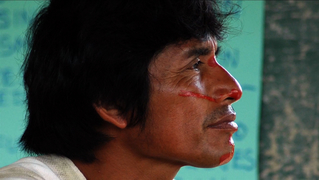
As the U.N. climate summit continues, protesters are gathering in downtown Lima for what organizers hope will be the largest climate march in the history of South America. Democracy Now! visits Casa de Convergencia TierrActiva, a house that has become a key organizing hub ahead of the march, to see how demonstrators are preparing.
Transcript
AMY GOODMAN: This is Democracy Now!, democracynow.org, The War and Peace Report. I’m Amy Goodman in Lima, Peru. As we end today’s show, protesters are gathering, downtown Lima, for what organizers hope will be the largest climate march in the history of South America. On Tuesday, Democracy Now! visited the TierrActiva convergence space that’s become a key organizing hub ahead of the march.
MAJANDRA RODRÍGUEZ: Hi. My name is Majandra Rodríguez. I’m part of TierrActiva Perú. We’re, along with TierrActiva Bolivia, running this convergence space called CasActiva, or the TierrActiva convergence house. This is a temporary location for local groups and also international groups, activists, artists, cultural groups, youths, citizens, activists, in general, to come, gather, learn from each other, exchange experiences. We have workshop spaces, meeting spaces. We also have art-making spaces. We have an alternative community radio space here in this house, as well. So, the idea is for people to come, to exchange and also to prepare actions, specifically focusing on the march tomorrow, which is Wednesday, 10th, which is hoping—we’re hoping it’s going to be the biggest climate rally in Latin America in history. And so, we’re preparing very much for that.
NICKY SCORDELLIS: My name is Nicky Scordellis, and I’m here with the TierrActiva movement from Bolivia, and we’re jointly running this space with TierrActiva Perú. Well, we see that climate change is a result of a system problem. So we’re trying to build alternatives that really confront the whole system, starting from how we live as people. So, for us, a really key point is about community. And we’re trying to live together in this house, both those of us who are actually living here and others who are coming and working here every day. And we’re trying to find ways of collaborating, ways of understanding each other. We’re, you know, sharing, so many people in this space.
We’re also working a lot with food as a real alternative. We have this project called “Conscious Food,” which is all about eating food which basically is rejecting the transnational companies, GMOs, you know, like chemicals, and we’re trying to eat organic, natural foods, vegetarian food, with less environmental impact. We’re doing this as a community kitchen every day, we’re running, with lunch and dinner. And also it’s a way of bringing everyone together around community.
ARIEL DE LA ROCHA: [translated] My name is Ariel de la Rocha, from Bolivia. I’m from the movement called Conscious Food. So the movement of Conscious Food began with a group of us climate change activists realizing the relationship between decisions we made about food and its impact on climate change. With our activism around climate change, we started to distribute more healthy food and put aside food products that emit more greenhouse gases. In this sense, we started to be involved with this house and part of the Active Earth Bolivia movement and to initiate actions around the COP and the People’s Summit.
AMY GOODMAN: Voices from the TierrActiva convergence space here in Lima, Peru. Tune in tomorrow for coverage of today’s climate march.













Media Options